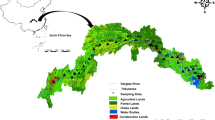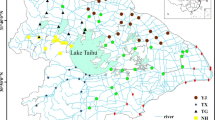Abstract
The environmental behaviors of five heavy metals (Cd, Cr, Cu, Pb, and Zn) in a Chinese oilfield were investigated using a steady-state multimedia aquivalence (SMA) model. The modeling results showed good agreement with the actual measured values, with average residual errors of 0.69, 0.83, 0.35, 0.16, and 0.54 logarithmic units for air, water, soil, sediment, and vegetation compartments, respectively. Model results indicated that most heavy metals were buried in sediment, and that transfers between adjacent compartments were mainly deposition from the water to the sediment compartment (48.59 %) and from the air to the soil compartment (47.74 %) via atmospheric dry/wet deposition. Sediment and soil were the dominant sinks, accounting for 68.80 and 25.26 % of all the heavy metals in the multimedia system, respectively. The potential ecological risks from the five heavy metals in the sediment and soil compartments were assessed by the potential ecological risk index (PERI). The assessment results demonstrate that the heavy metals presented low levels of ecological risk in the sediment compartment, and that Cd was the most significant contributor to the integrated potential ecological risk in the oilfield. The SMA model provided useful simulations of the transport and fate of heavy metals and is a useful tool for ecological risk assessment and contaminated site management.







Similar content being viewed by others
References
Ao JT, Chen JW, Tian FL et al (2009) Application of a level IV fugacity model to simulate the long-term fate of hexachlorocyclohexane isomers in the lower reach of Yellow River basin, China. Chemosphere 74:370–376
Beyer A, Biziuk M (2009) Environmental fate and global distribution of polychlorinated biphenyls. Rev Environ Contam T 201:137–158
Cao HY, Liang T, Tao S et al (2007) Simulating the temporal changes of OCP pollution in Hangzhou, China. Chemosphere 67:1335–1345
Chen JJ, Wang HQ, Xi CG et al (2001) Environmental impact of oil pollutant on groundwater during oilfield exploitation in Daqing—a modelling analysis. Chin J Appl Ecol 12:113–116
Das R, Kazy SK (2014) Microbial diversity, community composition and metabolic potential in hydrocarbon contaminated oily sludge: prospects for in situ bioremediation. Environ Sci Pollut Res 21(12):7369–7389
Diamond ML, Mackay D, Cornett RJ et al (1990) A model of the exchange of inorganic chemicals between water and sediments. Environ Sci Technol 24:713–722
Du XY, Liu JL, Zhang Y et al (2011) Relationship between soil biotoxicity and levels of heavy metals (Pb, Cd, Cu, Zn, Ni, Cr, Co, Sb, Fe, and Mn) in an oilfield from China. Fresen Environ Bull 20:121–126
Grec A, Maior C (2008) Earth oil extraction-major environmental pollution source. Environ Eng Manag J 7:763–768
Håkanson L (1980) An ecological risk index for aquatic pollution control: a sedimentlogical approach. Water Res 14:975–1001
Hou DK, He J, Lü CG et al (2013) Distribution characteristics and potential ecological risk assessment of heavy metals (Cu, Pb, Zn, Cd) in water and sediments from Lake Dalinouer, China. Ecotox Environ Safe 93:135–144
Hu Y, Wang DZ, Zhang C et al (2013a) An interval steady-state multimedia aquivalence (ISMA) model of the transport and fate of chloridion in a surface flow constructed wetland system treating oilfield wastewater in China. Ecol Eng 51:161–168
Hu Y, Zhang C, Wang DZ et al (2013b) Chloridion fate and transport in oil-field wastewater reuse by interval dynamic multimedia aquivalence model. Water Sci Technol 67:628–634
Hu Y, Wen JY, Li XL et al (2013c) A dynamic multimedia fuzzy-stochastic integrated environmental risk assessment approach for contaminated sites management. J Hazard Mater 261:522–533
Hu Y, Wen JY, Wang DZ et al (2013d) An interval dynamic multimedia fugacity (IDMF) model for environmental fate of PAHs and their source apportionment in a typical oilfield, China. Chem Ecol 29:476–488
Jiang XY, Zhao KF (2001) Mechanism of heavy metal injury and resistance of plants. Chin J Appl Environ Biol 7:92–99
Khan S, Cao Q, Zheng YM et al (2008) Health risks of heavy metals in contaminated soils and food crops irrigated with wastewater in Beijing, China. Environ Pollut 152:686–692
Kisic I, Mesic S, Basic F et al (2009) The effect of drilling fluids and crude oil on some chemical characteristics of soil and crops. Geoderma 149:209–216
Li Y, Hu Y, Du XY et al (2012) Investigation on the dynamic environmental behaviors of petroleum-derived polycyclic aromatic hydrocarbons in an oilfield, China. Fresen Environ Bull 21:986–994
Ling H, Mackay D, Diamond ML (1993) Application of the QWASI fugacity/aquivalence model to assessing sources and fate of contaminants in Hamilton Harbour. J Great Lakes Res 19:582–602
Luo XL, Zheng Y, Lin ZR et al (2015) Evaluating potential non-point source loading of PAHs from contaminated soils: a fugacity-based modeling approach. Environ Pollut 196:1–11
Mackay D, Diamond ML (1989) Application of the QWASI (Quantitative Water Air Sediment Interaction) fugacity model to the dynamics of organic and inorganic chemicals in lakes. Chemosphere 18:1343–1365
Mackay D, Paterson S (1991) Evaluating the multimedia fate of organic chemicals: a level III fugacity model. Environ Sci Technol 25:427–436
Mackay D (2001) Multimedia environmental models: the fugacity approach. Lewis Publishers, Chelsea
Marques MRDC, Souza PSAD, Rigo MM et al (2015) 2015) Effects of untreated and treated oilfield-produced water on seed germination, seedling development, and biomass production of sunflower (Helianthus annuus L. Environ Sci Pollut Res 22:15985–15993
Ötvös E, Kozák IO, Fekete J et al (2004) Atmospheric deposition of polycyclic aromatic hydrocarbons (PAHs) in mosses (Hypnum cupressiforme) in Hungray. Sci Total Environ 330:89–99
Sharpe S, Mackay D (2000) A framework for evaluating bioaccumulation in food webs. Environ Sci Technol 34:2373–2379
Song YX, Zheng HB (2002) Study on the optimum pattern of Daqing urban spatial structure. Chin Geogr Sci 12:206–211
Suzuki N, Yasuda M, Sakurai T et al (2000) Simulation of long-term environmental dynamics of polychlorinated dibenzo-p-dioxins and polychlorinated dibenzofurans using the dynamic multimedia environmental fate model and its implication to the time trend analysis of dioxins. Chemosphere 40:969–976
Tang J, Li N, Li HY et al (2012) Flux and source appointment of heavy metals from atmospheric dry and wet deposition in Daqing City, China. Journal of Jilin University (Earth Science Edition) 42:507–513
Tian HZ, Zhu CY, Gao JJ et al (2015) Quantitative assessment of atmospheric emissions of toxic heavy metals from anthropogenic sources in China: historical trend, spatial distribution, uncertainties, and control policies. Atmos Chem Phys 15:10127–10147
Yang J, Chen L, Liu LZ et al (2014) Comprehensive risk assessment of heavy metals in lake sediment from public parks in Shanghai. Ecotox Environ Safe 102:129–135
Ye HX, Zhang SC, Zhang M et al (2007) Study on adsorption and release of heavy metal in sediment of Tiebutie Pool in Daqing. Journal of Heilongjiang Hydraulic Engineering College 34:98–101
Yu WH, Zang SY, Wu CS et al (2011) Analyzing and modeling land use land cover change (LUCC) in the Daqing City, China. Appl Geogr 31:600–608
Zhang HX, Wang Y, Zhang X et al (2012) Application of orthogonal design in determination of trace metal elements in crude oils by ICP-AES. Chem Res Appl 24:614–616
Zhang LJ, Zhang DY, Zhang SC et al (2007) Transferring models for heavy metals in city wetland aquicolous ecosystem of Daqing, Heilongjiang Province. Journal of Beijing Forest University 29:277–282
Zhang Q, Ye JJ, Chen JY et al (2014) Risk assessment of polychlorinated biphenyls and heavy metals in soils of an abandoned e-waste site in China. Environ Pollut 185:258–265
Zhang Z, Hou Z, Yang C et al (2011) Degradation of nalkanes and polycyclic aromatic hydrocarbons in petroleum by a newly isolated Pseudomonas aeruginosa DQ8. Bioresource Technol 102:4111–4116
Acknowledgments
This study was supported by the Key Project of the National Science & Technology Pillar Program of the Eleventh Five-Year Plan (2008BAC43B01).
Author information
Authors and Affiliations
Corresponding author
Additional information
Responsible editor: Marcus Schulz
Rights and permissions
About this article
Cite this article
Hu, Y., Wang, D. & Li, Y. Environmental behaviors and potential ecological risks of heavy metals (Cd, Cr, Cu, Pb, and Zn) in multimedia in an oilfield in China. Environ Sci Pollut Res 23, 13964–13972 (2016). https://doi.org/10.1007/s11356-016-6589-1
Received:
Accepted:
Published:
Issue Date:
DOI: https://doi.org/10.1007/s11356-016-6589-1




